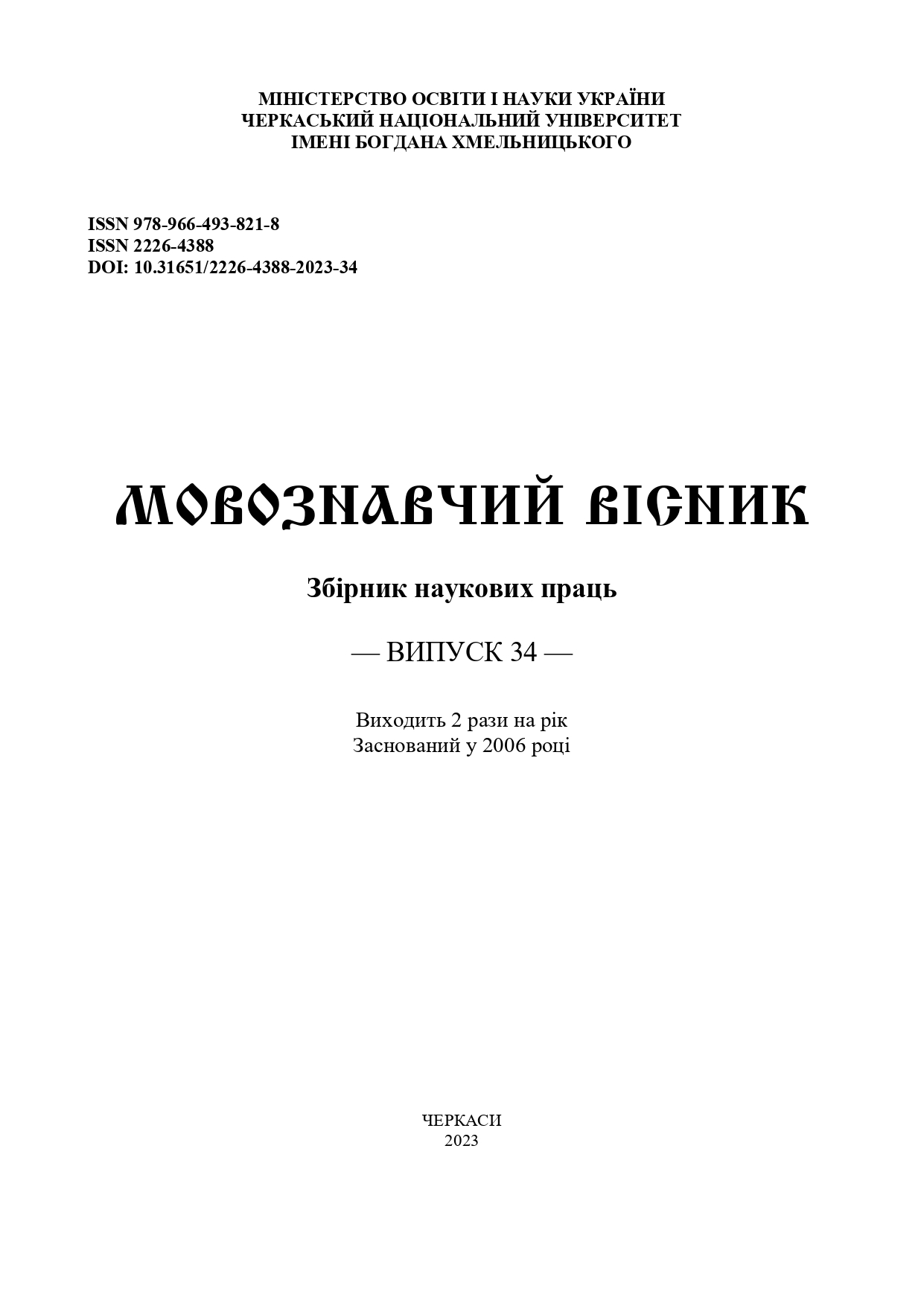FREE INDIRECT SPEECH AS MEANS OF DYNAMIZATION OF THE STORY
Main Article Content
Abstract
Introduction. Today, access to information is unlimited, and it provokes fatigue and loss of interest in learning new things. This especially applies to children who have not yet sufficiently developed the skills of concentration and focusing attention on one thing for a long time. Literature for children and youth performs a number of functions, among which educational, cognitive and socialization are the main ones, and therefore it needs effective mechanisms of attracting children’s attention to its product.
Contemporary Ukrainian children’s writer Zirka Menzatyuk emphasizes the importance of a high degree of dynamism in children’s literature, because it can make the fiction to be more competitive with other sources of information. Therefore, the study of linguistic means of dynamizing the narrative in texts for children becomes relevant in view of the insufficient degree of study of this issue and its importance in the processes of children’s cognition of the world.
The purpose. Purpose is to clarify the specifics of the functioning of free indirect speech as means of dynamizing the narrative in the story «Angel Golden Hair» written by Zirka Menzatiuk.
The methods. To achieve this goal involved the method of linguistic description, also the author of the article used structural approach and the elements of contextual analysis.
Main results of the study. Finding out what is depicted in the literary text and from which perspective it is done gives an understanding of the specifics of the functioning of the point of view in fiction. The relationship between the point of view and the inner speech is that when the author chooses to present the thoughts of the character in any form, he invites to see things from the perspective of the hero of the text, it means to become a reflector of the fictional world. The narrative structure of the analyzed story has a narrator from the third person, but fictional reality is presented using the consciousness of the main character of the text, it makes possible to classify this point of view, according to P. Simpson’s classification, to type B, a reflector subtype, in which the formation of the «center of consciousness» is the main feature. All forms of transmission of speech and thoughts are used to reflect the inner speech and thought of the character, her feelings, evaluations and conclusions, therefore, the main form of presentation of both speech and thoughts is free indirect speech. In the analyzed novel, the main type of free indirect speech is characterological, since it has signs of approaching direct speech, in particular exclamatory, interrogative sentences, evaluative and expressive vocabulary, which clearly emphasizes the specifics of the main character’s thinking. The structure of the presentation of the events in the story is represented by a consistent change of the character’s dialogues, the unspoken speech as a reaction to the depicted events, and the girl’s internal monologues-reflections on her problems and ways to solve them. A distinctive feature of the introduction of free indirect speech that conveys thoughts is the use of words to denote thought processes and emotional states. Another form of conveying thoughts is semi-direct speech, which highlights the thinking of secondary characters.
Originality. The scientific research is the first attempt to analyze the free indirect speech as means of dynamization of the story on the materials of works for children and youth.
Conclusion and specific suggestions of the author. The necessary part of understanding fiction in general is exploration of the means of expressing the narrative structures of this works. Free indirect speech makes possible to compress long monotonous descriptions into more emotionally saturated ones, it caused the effect of rapid change of events and continuity, it dynamizes the story. This author’s choice grabs the reader’s attention and keep it until the end of the story.
We see the prospect of further scientific research in the study of means of expressiveness of narrative structure on the material of works for children and youth.
Article Details
References
Andruschak, O. & Devlysh, I. (2020). Nevlasne priama movy v novelli «Vezha z chornoho dereva» Dzh.
Faulza : pragmatychnyi aspect [Free Indirect Speech in the novella «The Ebony Tower» John Fowles: Pragmatic
Aspect]. In : Molodyi vchenyi [Young Scientist], 2.1(78.1), 1–3 (in Ukr.).
Bekhta, I. (1997). Nevlasne-priama mova v strukturi zhanru malyh form (na materiali amerykanskoho short
story – XIX–XX stolittia) [Free Indirect Speech in the structure of the genre of small forms (based on the material of the
American short story of the 19th–20th centuries)]. PhD dissertation (Germanic languages). Lviv, 188 (in Ukr.).
Vavryniuk, T. (2004). Nevlasne-priama mova yak zasib subiektyvatsii tekstu [Free Indirect Speech as
means of text subjectivation]. In : Mandrivets [The traveler], 2, 45–47 (in Ukr.).
Vaschenko, V. (1958). Stylistychni yavyscha v ukrainskii movi [Stylistic phenomena in the Ukrainian
language]. Kharkiv : Vydavnytstvo HDU, 228 (in Ukr.).
Koval, A. (1987). Praktychna stylistyka ukrainskoi movy [Practical stylistics of the modern Ukrainian
language]. Kyiv : Vyscha shola, 352 (in Ukr.).
Krupa, M. (2010). Linhvistychnyi analiz hudozhnoho tekstu [Linguistic analysis of the artistic text].
Ternopil : Pidruchnyky i posibnyky, 496 (in Ukr.).
Levko, A. Zirka Menzatiuk: «Holovne scho ziavylasia insha molod» [Zirka Menzatyuk: «The main thing is
that other young people appeared»]. Avaliable at: http://www.barabooka.com.ua/golovne-shho-z-yavilas-insha-molod/
(in Ukr.).
Slovnyk ukrainsoi movy: v 11 tomah [Dictionary of the Ukrainian language: in 11 volumes]. Available at:
http://sum.in.ua/ (in Ukr.).
Shytyk, L. (2014). Synhronna perehidnist syntaksychnyh odynyts v ukrainskii literaturnii movi
[Synchronous transivity of syntactic units in the Ukrainian literary language]. Cherkassy : vydavets Chabanenko Yu.,
(in Ukr.).
Leech, G. & Short, M. (2007). Style in Fiction: A Linguistic Introduction to English Fictional Prose.
Edinburgh : Pearson Education Limited, 404 (in Eng.).
Short, M. (2013). Exploring the language of poems, plays and prose. London & New York: Routledge, 416
(in Eng.).
Simpson, P. (2005). Language, Ideology and Point of View. London & New York: Routledge, 184 (in Eng.).

